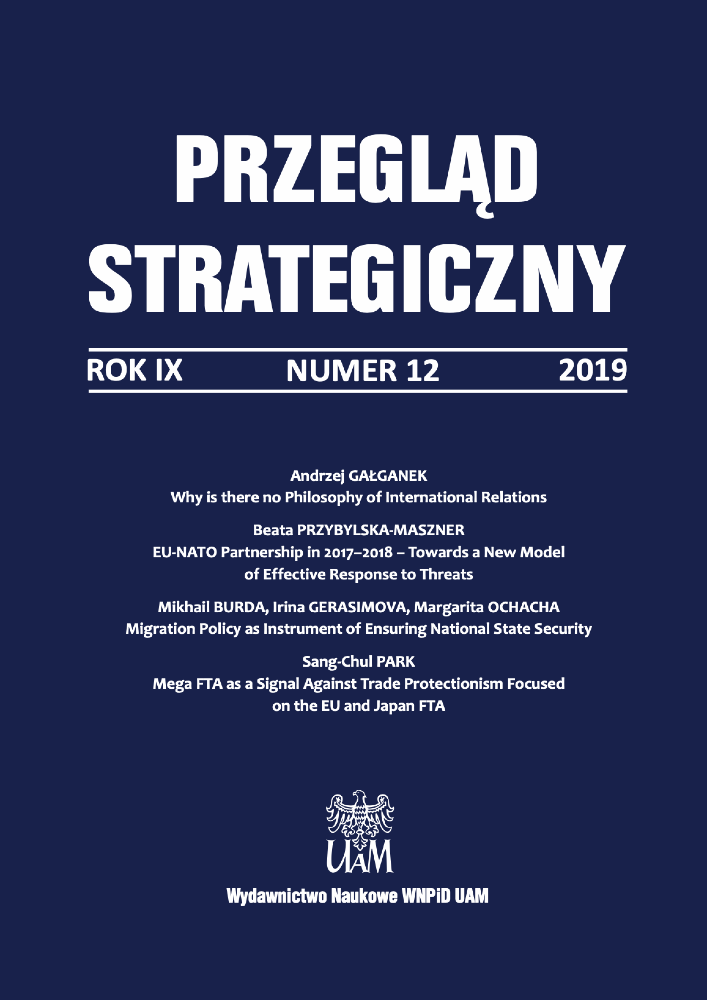Abstract
The goal of this publication is to confirm that the pattern of operation, developed based on the Krav Maga combat system and crisis management, provides an individual with safety against the threat of a street attack. At the beginning of the article, the issues of self-defence were discussed, the Krav Maga combat system was presented and the most important elements of the crisis management theory were introduced. Later in the paper, an analysis of each of the crisis management phases was carried out in relation to the risk of a street attack. The author answers the research questions in detail: What is the best source through which you can learn effective self-defence? How should an individual behave in particular phases of crisis management against the threat of a street attack to ensure its own safety? The analysis made in the paperwork based on available sources, observations and the author’s experience gained gives an unambiguous confirmation that combat systems are the best source through which one can learn effective self-defence, because they take into account all the elements that accompany a street attack. Following the scheme included in the publication, every person, regardless of age, sex or physical posture can effectively increase their own personal safety.
References
Abramczyk A., Ciczkowski W. (1999), Bezpieczeństwo człowieka w środowisku lokalnym, Olsztyn.
Chojnowski L. (2018), Bezpieczeństwo człowieka i społeczeństw w procesie dziejowym, Słupsk.
Cendrowski J. (1973), Psychologia walki i dowodzenia, Warszawa.
Dobrzyjałowski J. (1994), Samoobrona i techniki interwencyjne policji, Legionowo.
Drabik K. (2013), Bezpieczeństwo personalne i strukturalne, Warszawa.
Grocki R. (2012), Zarządzanie kryzysowe: dobre praktyki, Warszawa.
Grabińska T., Spustek H. (2013), Bezpieczeństwo personalne a bezpieczeństwo strukturalne państwa: wolność i bezpieczeństwo obywatela, Wrocław.
Hołyst B. (2014), Bezpieczeństwo: ogólne problemy badawcze, Warszawa.
Hołyst B. (2006), Psychologia kryminalistyczna, Warszawa.
Hołyst B. (2014), Bezpieczeństwo jednostki, Warszawa.
http://statystyka.policja.pl/st/wybrane-statystyki/bron/bronprzestepstwa/50844,Przestepstwa-przy-uzyciu-broni.html (26.03.2019).
https://ec.europa.eu/eurostat/statistics-explained/index.php?title=Archive:Crime_statistics/pl&oldid=257905 (26.03.2019).
http://kravtrening.pl/about/historia-krav-maga/ (23.03.2019).
Jabkowski P. (2006), Przestępczość a poczucie bezpieczeństwa wśród mieszkańców Poznania: analiza socjologiczna, Poznań.
Kucharski M. (2012), Bezpieczeństwo – dyscyplina w obszarze nauk społecznych, Łódź.
Kołodziejczyk K. (2010), Personalny wymiar bezpieczeństwa, Częstochowa.
Mcnab C. (2017), 501 sposobów samoobrony bez użycia broni, Czerwonak.
Marciniak R., Molek W., Stec K. (2011), Zarządzanie kryzysowe w systemie kierowania bezpieczeństwem narodowym, Warszawa.
Piwowarski J., Rozwadowski M. (2016), System zarządzania kryzysowego jako element bezpieczeństwa narodowego, Kraków.
Polcikiewicz Z. (2012), Teoria bezpieczeństwa, Wrocław.
The Act of 21 May 1999 on weapons and ammunition, Journal of Laws of 1999, No. 53, item 549, http://prawo.sejm.gov.pl/isap.nsf/download.xsp/WDU19990530549/U/D19990549Lj.pdf (25/03/2019).
The Act of 26 April 2007 on crisis management, Journal of Laws of 2007, No. 89, item 590, http://prawo.sejm.gov.pl/isap.nsf/download.xsp/WDU20070890590/U/D20070590Lj.pdf (25/03/2019).
PWN Polish Dictionary (2015), Wydawnictwo Naukowe PWN, Warsaw.
Wróblewski R. (2013), Zarządzanie kryzysowe jako element zarządzania bezpieczeństwem narodowym, Siedlce.

